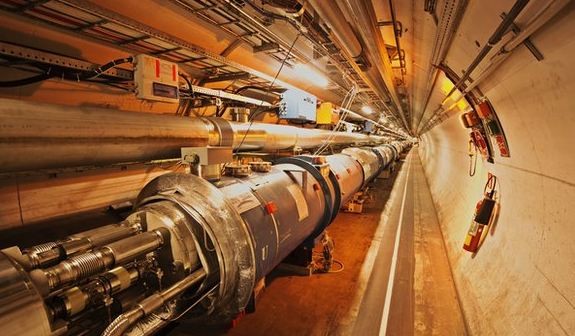The Large Hadron Collider (LHC) has smashed protons together for the first time since early 2013, announced CERN or the European Organization for Nuclear Research in Switzerland.
The low-energy collision experiments were part of preparations for the second round of experiments scheduled to begin June 1 where then LHC will be accelerated to its new peak design power of 7,000 gigaelectronvolts (GeV) for each of its two beams.
During the May 5 tests, proton beams circled the LHC and collided at energies of 450 GeV per beam. CERN reported the two beams have been steered into each other, an important step in the gradual restart of the world's largest particle accelerator housed in a 27 kilometer long circular subterranean tunnel in Switzerland.
LHC uses powerful magnets to bend beams containing billions of protons hurtling along at 99.9 percent the speed of light. These particles collide at points around the circular track where four laboratories monitor the smashups.
"It's a nice milestone today. There were a lot of smiling faces in the control room," said Dave Charlton, spokesperson for the LHC's huge multipurpose Atlas detector.
"From what we've seen so far, everything looks good. Having collisions like these means we will be much more ready for high energy collisions when they come".
Experiments using the LHC aim to unlock clues as to how the Universe came into existence by studying particles considered the building blocks of matter and the forces that control them. In 2012, scientists proved the existence of Higgs Boson, the so-called God Particle, using the LHC.
On June 1, collisions will first take place at the new, historic energies of 7,000 GeV for calibration. Actual physics collisions with usable results will start later.
During this stage of the LHC program, physicists will be looking at an area known as "New Physics" that include anti-matter and dark matter. Other results might reveal the existence of the hidden dimensions by which gravity spreads throughout the Universe.
"These are the first colliding beams in the machine for over two years, and it brings home that physics collisions are close," said Prof. Tara Shears from the University of Liverpool, who works on LHCb, one of four big experiments spaced around the LHC's ring where the collisions occur.
"This time, we used the data to make sure subdetectors are time-aligned with each other," she said to BBC News.
"We have a shopping list of checks to do; checking the trigger, our luminosity calculation, the performance of each part of our experiment, and we'll work through this with these collision runs."



























